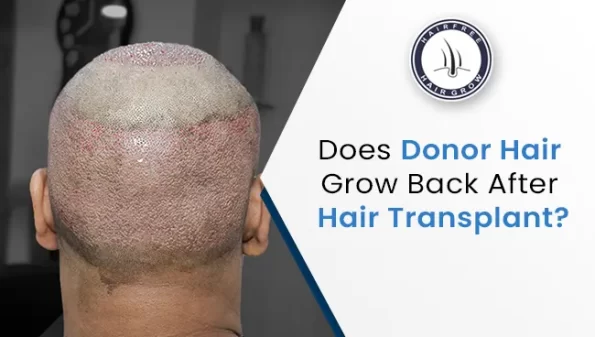Hair transplant is a widely popular cosmetic procedure to restore hair growth in areas where baldness or thinning has occurred. It involves taking hair follicles from one part of the scalp (donor site) and transplanting them to the bald or thinning area (recipient site). As the procedure involves taking hair follicles from the scalp, one common question that arises is whether the donor’s hair grows back after a hair transplant. The short answer is yes, and the donor’s hair does grow back after a hair transplant. Discover does donor hair grows back after a hair transplant. Here’s what you need to know!
However, there are certain factors that can affect the growth rate and quality of the transplanted hair as well as the donor area. In this discussion, we will delve deeper into the topic of donor hair growth after a hair transplant and explore some of the important factors that can impact the overall success of the procedure.
Will Donor Site Hair Grow Back?
Yes, the hair on the donor site can grow back after a Follicle Unit Extraction (FUE) or Follicular Unit Transplant (FUT) procedure, although the process may vary slightly between the two techniques.
In FUE, where individual hair follicles are cherry-picked from the donor area, the hair usually starts growing back in about 3 months. However, since the hair follicles are fully extracted, the individual hairs do not technically “grow back” in the same place. But because the extraction is done from the densest areas of the donor area, the overall appearance of the donor area is not noticeably affected over time.
On the other hand, FUT involves the surgical removal of a strip of donor area, which is then used for transplantation. The donor area is closed with stitches, and although the strips of skin removed are thin to minimize scarring, it may require a second FUT procedure to achieve the desired effect. However, with proper healing and care, the hair on the donor area can grow back, and the scar can become less noticeable over time.
It’s important to consult with a qualified and experienced hair transplant surgeon to determine the best technique for your specific needs and to understand the potential for regrowth in the donor area after the procedure.
What Happens to The Donor Area After Hair Transplant?
The donor area is the area on the scalp where hair follicles are harvested from for transplantation during a hair transplant procedure. This area is usually located at the back or sides of the head where hair growth is denser and not prone to balding.
After hair follicles are extracted from the donor area, the surrounding skin will undergo a healing process. The initial healing period typically lasts about two weeks, during which time the scalp may feel tender and sore. Patients may also experience some mild swelling and redness in the donor area, which should subside within a few days.
In most cases, the donor area will start to regenerate new hair within a few months after the procedure. However, it’s important to note that the density of hair in the donor area may be slightly reduced following the extraction process.
Typically, a skilled surgeon will extract hair follicles in a way that minimizes any visible scarring in the donor area. With modern techniques like Follicular Unit Extraction (FUE), individual hair follicles can be removed without creating large incisions or causing significant damage to surrounding tissues. As a result, patients can expect their donor area to heal quickly and with minimal scarring.
It’s worth noting that in some rare cases, patients may experience complications such as excessive scarring or damage to the donor area. This is why it’s important to choose an experienced and qualified hair transplant surgeon who can minimize the risk of complications and ensure optimal results.
How Do I Take Care of My Donor Area After Hair Transplant?
Taking good care of your donor area after a hair transplant is an important part of ensuring proper healing and minimizing the risk of complications. Here are some tips for caring for your donor area after a hair transplant:
- Keep the area dry: For the first few days after the procedure, it’s important to keep the donor area dry. Avoid showering or washing your hair during this time. Your surgeon may provide you with specific instructions on when and how to start washing your hair.
- Avoid strenuous activity: It’s important to avoid strenuous exercise or other physical activities that could cause sweating or rubbing of the scalp for at least a week following the procedure.
- Sleep in an upright position: For the first few nights after the procedure, try to sleep in an upright position to help reduce swelling and discomfort.
- Apply ice packs: Applying ice packs to the donor area can help reduce swelling and discomfort. Be sure to wrap the ice pack in a towel or cloth to avoid direct contact with the scalp.
- Take medications as prescribed: Your surgeon may prescribe pain medication or antibiotics following the procedure. Be sure to take these medications as prescribed to help manage any discomfort and prevent infection.
- Follow your surgeon’s instructions: Your surgeon will provide you with detailed post-operative instructions. Be sure to follow these instructions carefully, as they will vary depending on the specific technique used and the individual patient’s needs.
By taking good care of your donor area after a hair transplant, you can help ensure proper healing and optimal results. If you have any concerns or questions about caring for your donor area after the procedure, be sure to consult with your surgeon.
Conclusion
In conclusion, hair transplant surgery is a highly effective and popular solution for individuals who are struggling with hair loss. It involves transferring healthy hair follicles from a donor area to the recipient area, where new hair will grow. After the hair transplant surgery, it’s natural to wonder whether the donor hair will grow back. Hope this blog will help you to give answer of your question which you find.
Written By
MBBS, MD
Dr. Pratibha Pradhan is a renowned hair transplant specialist with a wealth of experience in the field of hair restoration. They have a particular expertise in understanding the dynamics of donor hair growth post-transplant.
Disclaimer
We’ve made all possible efforts to ensure that the information provided here is accurate, up-to-date and complete, however, it should not be treated as a substitute for professional medical advice, diagnosis or treatment. See Detailed Disclaimers Here.



